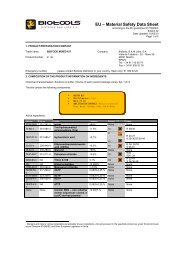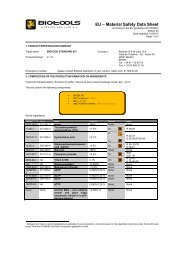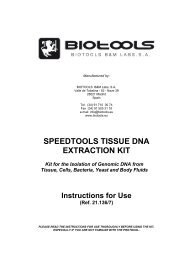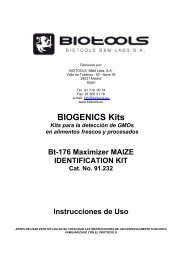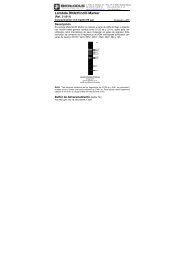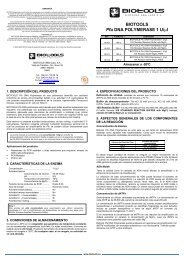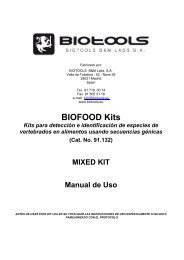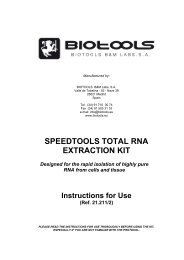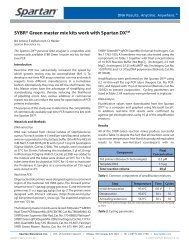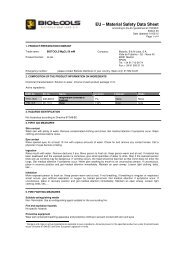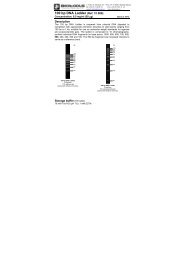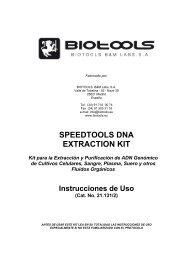BIOTOOLS DNA POLYMERASE 5 U/µl
BIOTOOLS DNA POLYMERASE 5 U/µl
BIOTOOLS DNA POLYMERASE 5 U/µl
Create successful ePaper yourself
Turn your PDF publications into a flip-book with our unique Google optimized e-Paper software.
WARRANTYProducts are guaranteed to conform to the quality and content indicated on each vial and external labels during their shelf life.<strong>BIOTOOLS</strong> obligation and purchaser’s rights under this warranty are limited to the replacement by <strong>BIOTOOLS</strong> of any product thatis shown defective in fabrication, and that must be returned to <strong>BIOTOOLS</strong>, freight prepaid, or at <strong>BIOTOOLS</strong>’ option, replacement ofthe purchasing price. Any complaint on damaged goods during transport must be directed to the handling or transport agent.Product for Research Use Only. This product must be used by qualified professionals only. It is the responsibility of the user toascertain that a given product is adequate for a given application. Any product not fulfilling the specifications included in the productsheet will be replaced. This warranty limits our responsibility to the replacement of the product. No other warranties, of any kind,express or implied, including, without limitation, implicit warranties of commercialisation ability or adequacy for a given purpose, areprovided by <strong>BIOTOOLS</strong>. <strong>BIOTOOLS</strong> will not be held responsible for any direct, indirect, consequential or incidental damageresulting of the use, misuses, results of the use or inability to use any product.Produced by:<strong>BIOTOOLS</strong>, Biotechnological & Medical Laboratories, S.A. have been evaluated and certified to accomplish ISO9001:2000 requirements for the following activities: Research and development of biotechnology products andmanufacture of biotechnology and in vitro products. Valle de Tobalina – 52 – Nave 39, 28021 Madrid – Spain© 2008 <strong>BIOTOOLS</strong>, Biotechnological & Medical Laboratories, S.A. All rights reserved<strong>BIOTOOLS</strong> B&M Labs, S.A.Valle de Tobalina - 52 - Nave 3928021 MadridSpainTel. (34) 91 710 00 74Fax (34) 91 505 31 18E-mail: info@biotools.euwww.biotools.eu1. GENERAL CONSIDERATIONS<strong>BIOTOOLS</strong> <strong>DNA</strong> Polymerase is a modified thermostable recombinant <strong>DNA</strong>polymerase from the thermophilic bacterium Thermus sp. expressed in E. coli. Thegeneral characteristics of <strong>BIOTOOLS</strong> <strong>DNA</strong> Polymerase make the enzyme suitablefor applications requiring a highly thermostable and processive enzyme capable ofsynthetising <strong>DNA</strong> strands at elevated temperatures in amplification or similarreactions (e.g. primer extension), thus resolving the most complex secondarystructures.Due to its processivity and accuracy <strong>BIOTOOLS</strong> <strong>DNA</strong> Polymerase allows thegeneration of long templates with a base misincorporation rate (1-10 x 10 -6 bp) lowerthan most commercial Taq <strong>DNA</strong> polymerases.The procedure employed for the purification of thermostable enzymes is proprietaryof Biotools. It involves a simple and non chromatographic procedure which renders atop high yield and quality enzyme.The enzyme is supplied at a concentration of 5 U/<strong>µl</strong> in a storage buffer. This concentrationfacilitates performance of high throughput amplification experiments and management ofreduced reaction volumes.Product applications:• Standard PCR• Multiplex PCR• In situ PCR• <strong>DNA</strong> sequencing• Other reactions requiring <strong>DNA</strong> synthesis at high temperature2. ENZYME FEATURESConcentration: ........................................................ 5 U/<strong>µl</strong>Performance:Working concentration ............... 20-25 mU/<strong>µl</strong>pH.............................................. 8-9Elongation temperature ............. 72ºCMgCl 2 concentration .................. 2 mMSize of PCR products: ............................................ Up to 5 KbPCR cloning: ..................................... ..................... T/AEndonuclease activity: ............................................ NoReverse transcriptase activity: ................................ No5´→3´exonuclease activity: ..................................... Yes3´→5´exonuclease activity: ..................................... NoNicking activity ........................................................ NoNote:This enzyme is not recommended for certain experiments dealing with amplification ofsequences homologous to those found in E. coli.3. STORAGE CONDITIONSStore package components at -20ºC in a constant temperature freezer. Underthese conditions enzyme activity remains unaltered over a 24 months period. Theglycerol present in the storage buffer prevents the enzyme from freezing at -20ºC.If the enzyme is frozen, its activity is not altered.<strong>BIOTOOLS</strong><strong>DNA</strong> <strong>POLYMERASE</strong> 5 U/<strong>µl</strong>REF. FORMAT CONTENT10.042 500 U10.043 1000 U10.044 5000 U (5x1000 U)10.047 500 U10.048 1000 U10.049 5000 U (5x1000 U)Biotools <strong>DNA</strong> Polymerase (5 U/<strong>µl</strong>)10X Standard Reaction Buffer with MgCl 2Biotools <strong>DNA</strong> Polymerase (5 U/<strong>µl</strong>)10X Standard Reaction Buffer with MgCl 2Biotools <strong>DNA</strong> Polymerase (5 U/<strong>µl</strong>)10X Standard Reaction Buffer with MgCl 2Biotools <strong>DNA</strong> Polymerase (5 U/<strong>µl</strong>)10X Reaction Buffer MgCl 2 FREEBiotools <strong>DNA</strong> Polymerase (5 U/<strong>µl</strong>)10X Reaction Buffer MgCl 2 FREEBiotools <strong>DNA</strong> Polymerase (5 U/<strong>µl</strong>)10X Reaction Buffer MgCl 2 FREEStore at -20°CNotice to users: Some of the applications which may be performed with this product are covered by applicablepatents in certain countries. The purchase of this product does not include or provide a license to perform patentedapplications. Users may be required to obtain a license depending on the country and/or application.Ed.06- April 104. PRODUCT SPECIFICATIONSUnit Definition- One unit is defined as the amount of enzyme which incorporates 10nanomoles of dNTPs into acid-insoluble <strong>DNA</strong> within 30 min at 72 ºC.Storage Buffer- 10 mM Tris-HCl (pH 8.0), 50 mM KCl, 1 mM EDTA, 0.1% Triton X-100, 50% glycerol (v/v).10X Reaction Buffer- 750 mM Tris HCl (pH 9.0), 500 mM KCl, 200 mM (NH 4 ) 2 SO 4 .The 10X STANDARD REACTION BUFFER with MgCl 2 includes 20 mM MgCl 2 inits composition.5. GENERAL ASPECTS OF REACTION COMPONENTSEnzyme ConcentrationAs an initial guide we recommend employing the following enzyme units/rxn.Final reaction volume Recommended enzyme units100 <strong>µl</strong> Up to 2.5 U50 <strong>µl</strong> 1-1.25 U25 <strong>µl</strong> 0.5-0. 625 UThe addition of higher quantities of enzyme generally does not produce significantyield increase. Only for certain applications or when working on long <strong>DNA</strong> fragmentamplifications (longer than 2 Kb from genomic <strong>DNA</strong>) it might be necessary toincrease the concentration.<strong>DNA</strong> TemplateThe quality and quantity of the <strong>DNA</strong> template affects both the sensitivity andefficiency of the amplification. High amounts of <strong>DNA</strong> usually increase theamplification of nonspecific PCR products.The PCR is inhibited by various compounds i.e. ionic detergents, phenol, gel loadingdyes, etc. If the template contains traces of inhibitors, reduce the amount of the <strong>DNA</strong>included in the amplification reaction, or repurify the template by ethanolprecipitation and several washing steps.dNTPs ConcentrationGenerally equal concentrations of all four dNTPs are used. The concentration ofeach dNTP should be 50-500 µM, being 200 µM the most commonly usedconcentration. Biotools offers equimolar mixes of dNTPs (10 mM and 25 mM each).The concentration of dNTPs may be decreased (e.g. when unspecific amplificationoccurs), increased (e.g. for long amplifications), or even unbalanced in favour of anyof the particular dNTPs (e.g. in vitro mutagenesis experiments). Biotools <strong>DNA</strong>Polymerase is suitable for its use with modified dNTPs (e.g. radioactively orfluorescein labelled) as substrates. It can also be used with dUTP and otheranalogues.The dNTPs behave as potent Mg 2+ chelating agents reducing therefore theavailability of free Mg 2+ for polymerase activity. Thus an increase in dNTPs shouldbe accompanied by an increase in MgCl 2 concentration.Reaction BufferThe provided buffer has been specially formulated to facilitate the amplification ofany PCR products. It creates the appropriate stringent conditions for primerannealingover a wide range of temperatures. Moreover, the Standard ReactionBuffer with MgCl 2 includes Mg 2+ at the optimal concentration for most experiments(final concentration: 2 mM).
MgCl 2 ConcentrationThe optimal MgCl 2 concentration may vary depending on the primer and templatethat are used and must be determined by experimentation. In most cases, a finalconcentration of MgCl 2 at 2 mM in the reaction mix works well.High concentrations of MgCl 2 may promote low enzyme fidelity and non specificamplification products; whereas low concentrations should reduce the yield of thedesired amplification products. If the samples contain any chelating metal agentssuch as EDTA, the concentration of MgCl 2 should be increased accordingly.Primer DesignPCR primers are usually 15-30 nucleotides in length with a content of 40-60% G+Cresidues. To avoid primer-dimer and hairpin formation the primers should not beself-complementary or complementary to any other primer present in the reactionmixture. The annealing temperature of the primers should be similar (< 5ºCvariation). Length and G+C content of primers are used to predict their annealingtemperature to the template <strong>DNA</strong>. The 5´end of a primer may contain mismatchesbetween the primer and template, whereas this is not recommended at the 3´end.PCR AdditivesIn certain cases the presence of DMSO, betaine, formamide or any other PCRadditives might be necessary for optimized complex PCR reactions. The providedenzyme and buffer are compatible with most PCR additives. When calculating theannealing temperature for the PCR cycling program, it is important to take intoaccount that certain additives may decrease the melting temperature of the primers.6. STANDARD PROTOCOLOptimal conditions must be determined for each individual experimental system.Proceed to the Reagent Preparation Area in a laminar flow cabinet. Wear disposable glovesand use sterile and nuclease free plastic material in order to avoid contaminations and falsenegative results.1. Thaw reagents at room temperature or on ice. After complete thawing, mix thereagents well, spin down in a bench-top centrifuge and keep on ice.2. Prepare a master mix in a sterile microcentrifuge tube according to Table 1. Foreach experiment include at least one negative control (without template <strong>DNA</strong>). Toensure sufficient volume for all desired reactions include additional reactions in thecalculations.TABLE 1. Master Mix preparationCOMPONENT Final 50 <strong>µl</strong> rxn 20 <strong>µl</strong> rxnConcentrationMaster Mix10X REACTION BUFFER 1X 5 <strong>µl</strong> 2 <strong>µl</strong>50 mM MgCl 2 solution* 1.5-4 mM 1.5-4 <strong>µl</strong> 0.6-1.6 <strong>µl</strong>dNTP Mix 10 mM each 200 µM of each 1 <strong>µl</strong> 0.4 <strong>µl</strong>Primers variable variable variable<strong>DNA</strong> Polymerase (5 U/<strong>µl</strong>) 20-25 mU/<strong>µl</strong> 0.2-0.25 <strong>µl</strong> 0.08-0.1 <strong>µl</strong>Sterile bidistilled water - Up to 50 <strong>µl</strong> Up to 20 <strong>µl</strong>Template <strong>DNA</strong> Variable Variable Variable*not necessary for 10X Standard Reaction Buffer because it includes MgCl 23. Mix the master mix thoroughly and keep on ice. Distribute the appropriate volumeinto each vial.Proceed to <strong>DNA</strong> Purification Area separate from other sources of <strong>DNA</strong>.4. Add the template <strong>DNA</strong> to each reaction vial. Close the vials and mix gently. Forthermal cycler without heated lid overlay a mineral oil layer.Proceed to the Amplification Area5. Program the thermal cycler according to the guide of the amplification program(see Table 2 and Section 7). Place the vials in the thermal cycler and perform theselected PCR program.TABLE 2. Standard Amplification ProgramCYCLE STEP Nº CYCLES TEMPERATURE TIMEInitial Denaturation 1 94ºC 3-10 min**DenaturationAnnealingExtension25-35*94ºCT m -5ºC72ºC5-60 sec30-60 sec60 sec/1 KbFinal Extension 1 72ºC 5-15 minCooling ∞ 4ºC ∞*Optimize the time, the temperature and the number of cycles of the PCR.**Depending on the template.7. GUIDE TO AMPLIFICATION PROGRAMInitial Denaturation Step-Incomplete denaturation of the PCR reaction results inan inefficient first amplification cycle and low amplification yield. However, thedenaturation must be kept as short as possible in order to avoid inactivation of theenzyme. For most samples 94ºC for 3-5 min should be satisfactory; templates rich inG+C often require a longer step (up to 10 minutes).Denaturation Step-The PCR product synthesized in the amplification cycling isshorter than the template <strong>DNA</strong> and therefore needs a short denaturation step; 5-60sec of denaturation at 94ºC should be sufficient.Primer Annealing Step-In general for primers < 20 bases the optimal annealingtemperature is equal to the T m of the lowest T m primer. To find the optimal annealingtemperature, you can use a temperature gradient. Start using an annealingtemperature 5 ºC bellow T m of the primers. If primers have a high T m a two stepcycling is recommended.Extension Step-The annealed primers must be extended at 70-75ºC. Theextension time depends on the size of the expected product. For Biotools <strong>DNA</strong>Polymerase we recommend 1 min for each Kb of expected product.Number of PCR Cycles-Cycling program usually consists on 25-35 cycles. Thisparameter depends on the amount of starting material and the expected yield. Incertain experiments, increasing the number leads to an increase in nonspecificproducts. You should experimentally determine the optimal number of cycles.Final Extension Step-After the last PCR cycle the sample should be incubatedat 72ºC for 5-15 min. The <strong>DNA</strong> polymerase fills the protruding ends of the newlysynthesized PCR products and adds extra adenine nucleotides to the 3´ends of thePCR product.8. TROUBLESHOOTINGProblem Cause RecommendationLow yield ornoamplificationproductNonspecificamplificationproducts orbackgroundsmearPCR productsin negativecontrolMissing reagentor pipetting error<strong>DNA</strong> templateproblemsProblems withprimersEnzymeconcentrationtoo lowMgCl2concentrationIncorrect PCRcyclingconditionsAnnealingtemperature toolowProblems withprimersExcess of <strong>DNA</strong>templateEnzymeconcentration toohighMgCl2concentrationIncorrect PCRcyclingconditionsCarryovercontamination9. ORDERING INFORMATIONCheck concentration and storage conditions of dNTPs, primers, etc.Repeat the PCR.Check the concentration and quality of starting material.If the template is difficult e.g. rich in G+C sequences we recommendadding DMSO to the master mix.Repeat the PCR with a new dilution of template or with a new <strong>DNA</strong>purification.Revise the primers design and the primers storage condition. Avoidany design prone to the formation of primer dimmers.Repeat PCR with different primer concentration from 0.1-0.5 µM in0.1 increments.Check primer degradation on a denaturing polyacrylamide gel.Increase enzyme concentration in 0.2 U increments.Optimise MgCl2 concentration of the PCR if necessary (1.5-4 mM)Check the following parameters of the PCR program:Denaturation- Increase time and temperature of initial denaturation.Annealing- Optimise the annealing temperature and time.Extension time- Increase extension time by increments of 30 sec.Number of cycles-Perform additional cycles by increments of 5cycles.Verify the final elongation step.Increase the annealing temperature in increments of 1ºC.Design alternative primers.Both primers should be present at the same concentration (0.1-0.5µM). Decrease primer concentration by increments of 0.1 µM .Check primer degradation on a denaturing polyacrylamide gel.Use dilutions of your template.Optimise polymerase concentration of the PCR if necessaryOptimise MgCl2 concentration of the PCR if necessary (1.5-4 mM)To increase the specificity you can perform a touchdown or stepdownPCR.Reduce the number of cycles.Exchange all reagents.DESCRIPTION Size ReferenceBiotools <strong>DNA</strong> Polymerase (5U/ <strong>µl</strong>) 500 U 10.0421000 U 10.0435 x 1000 U 10.044500 U 10.0471000 U 10.0485 x 1000 U 10.04910X Standard Reaction Buffer with MgCl 2 2 x 1.8 ml 10.0423 x 1.8 ml 10.04315 x 1.8 ml 10.04410X Reaction Buffer MgCl 2 FREE 2 x 1.8 ml 10.0473 x 1.8 ml 10.04815 x 1.8 ml 10.04950 mM MgCl 2 Solution 1.8 ml 10.0472 x 1.8 ml 10.04810 x 1.8 ml 10.049



